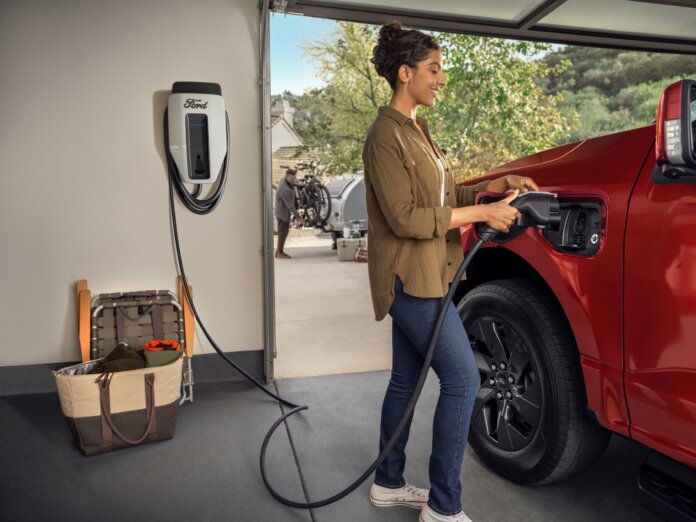Duke Energy and Ford Motor Co. are expanding vehicle-to-grid (V2G) charging using the new F-150 Lightning electric truck’s rugged batteries as a workhorse at home and on the electric grid.
Duke Energy has filed for North Carolina Utilities Commission (NCUC) approval of a new demand response pilot program expected to launch in 2023 for customers in the Duke Energy Carolinas (DEC) service area. Pilot incentives will reduce vehicle lease payments for program participants who lease an eligible electric vehicle (EV), including Ford F-150 Lightning trucks. In exchange, customers will allow their EVs to feed energy back to the grid – helping to balance it during peak demand.
This bidirectional, or two-way, flow of power is a smart charging technology also known as vehicle-to-grid (V2G) integration. V2G can push and pull energy between a connected EV and the grid, supplying the grid with stored, charged power and helping balance energy consumption and production.
“Duke Energy is building a more intelligent, sustainable, smart grid designed to encompass growing energy demands,” says Harry Sideris, executive vice president of customer experience, solutions and services at Duke Energy. “We’re working to maximize the benefits and potential of EVs for our customers – and initiatives like this can help reduce EV cost while supporting the grid during critical times.”
Duke Energy Carolinas serves about 2.1 million households and businesses in central and western North Carolina, including Charlotte, Durham and the Triad.
“North Carolina is quickly becoming a magnet for EV manufacturers and suppliers and innovative initiatives like this will help make our state even more attractive to this thriving industry,” states Stephen De May, Duke Energy’s North Carolina president.
As part of the pilot program, Duke Energy will enroll up to 100 customers who lease EVs including the Ford F-150 Lightning. Duke Energy will provide a financial incentive to customers in the form of reducing lease payments for program participants – providing payments directly to the vehicle manufacturer – in exchange for allowing Duke Energy to draw energy from their EVs.
The pilot program will allow Duke Energy to draw energy up to three times per month during higher peak winter and summer months, and one time per month during the remaining months of the year, for testing and research purposes and to support the energy grid during peak usage hours. Stored energy drawn from the EVs’ batteries will help balance the power grid during periods of highest energy demand.
Program participants will need the necessary bidirectional charging infrastructure, which includes the Ford Charge Station Pro home charger and Ford’s Intelligent Backup Power Home Integration System, which enables Ford F-150 Lightning customers to power their homes for three to 10 days in a power outage, installed in their home. Additionally, customers will need Ford’s software package to enroll in the program.
As part of the pilot program, Duke Energy will analyze flows of energy between EV batteries and the power grid and work closely with Ford and other vehicle manufacturers to study the full functionality of bidirectional charging integration. The company will also make determinations about how future customer demand response programs around V2G technology might be structured to provide maximum benefits to both customers and the grid.
“Ford’s electric vehicles are unlocking new possibilities in energy management for our customers, becoming valuable energy storage sources that are changing the game on the benefits an EV can deliver,” mentions Steven Croley, chief policy officer and general counsel at Ford Motor Co. “Alongside Duke Energy and our mutual customers, we’re working to fine-tune and expand these capabilities that will not only power their lives, but also accelerate the development of a less carbon-intensive grid.”
Duke Energy and Ford are also collaborating on a complimentary small-scale research and development test in Florida to begin in 2023.
“Duke Energy is making improvements now to ready the grid for more renewables and technologies like vehicle-to-grid,” adds Sideris. “It’s part of our commitment to significantly expand cleaner energy and achieve net-zero carbon emissions from electricity generation by 2050.”
Duke Energy is also working to build a smart-thinking grid that intelligently manages the two-way power flow needed to sustainably grow renewables like EV-generated energy.





